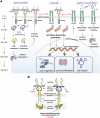Functional selectivity of Receptor Tyrosine Kinases regulates distinct cellular outputs
- PMID: 38259512
- PMCID: PMC10800419
- DOI: 10.3389/fcell.2023.1348056
Functional selectivity of Receptor Tyrosine Kinases regulates distinct cellular outputs
Abstract
Functional selectivity refers to the activation of differential signalling and cellular outputs downstream of the same membrane-bound receptor when activated by two or more different ligands. Functional selectivity has been described and extensively studied for G-protein Coupled Receptors (GPCRs), leading to specific therapeutic options for dysregulated GPCRs functions. However, studies regarding the functional selectivity of Receptor Tyrosine Kinases (RTKs) remain sparse. Here, we will summarize recent data about RTK functional selectivity focusing on how the nature and the amount of RTK ligands and the crosstalk of RTKs with other membrane proteins regulate the specificity of RTK signalling. In addition, we will discuss how structural changes in RTKs upon ligand binding affects selective signalling pathways. Much remains to be known about the integration of different signals affecting RTK signalling specificity to orchestrate long-term cellular outcomes. Recent advancements in omics, specifically quantitative phosphoproteomics, and in systems biology methods to study, model and integrate different types of large-scale omics data have increased our ability to compare several signals affecting RTK functional selectivity in a global, system-wide fashion. We will discuss how such methods facilitate the exploration of important signalling hubs and enable data-driven predictions aiming at improving the efficacy of therapeutics for diseases like cancer, where redundant RTK signalling pathways often compromise treatment efficacy.
Keywords: EGFR; FGFR; cell signalling; functional selectivity; ligand bias; ligand concentration; modelling; receptor tyrosine kinase (RTK).
Copyright © 2024 Samad, Schwartz and Francavilla.
Conflict of interest statement
The authors declare that the research was conducted in the absence of any commercial or financial relationships that could be construed as a potential conflict of interest.
Figures

Similar articles
-
Ligand bias in receptor tyrosine kinase signaling.J Biol Chem. 2020 Dec 25;295(52):18494-18507. doi: 10.1074/jbc.REV120.015190. Epub 2020 Oct 29. J Biol Chem. 2020. PMID: 33122191 Free PMC article. Review.
-
A functional RNAi screen for regulators of receptor tyrosine kinase and ERK signalling.Nature. 2006 Nov 9;444(7116):230-4. doi: 10.1038/nature05280. Epub 2006 Nov 1. Nature. 2006. PMID: 17086199
-
Application of computational approaches to study signalling networks of nuclear and Tyrosine kinase receptors.Biol Direct. 2010 Oct 11;5:58. doi: 10.1186/1745-6150-5-58. Biol Direct. 2010. PMID: 20937105 Free PMC article.
-
Crosstalk coregulation mechanisms of G protein-coupled receptors and receptor tyrosine kinases.Methods Mol Biol. 2006;332:51-77. doi: 10.1385/1-59745-048-0:51. Methods Mol Biol. 2006. PMID: 16878685 Review.
-
Reciprocal priming between receptor tyrosine kinases at recycling endosomes orchestrates cellular signalling outputs.EMBO J. 2021 Jul 15;40(14):e107182. doi: 10.15252/embj.2020107182. Epub 2021 Jun 4. EMBO J. 2021. PMID: 34086370 Free PMC article.
Cited by
-
FGFR2 residence in primary cilia is necessary for epithelial cell signaling.J Cell Biol. 2025 Jul 7;224(7):e202311030. doi: 10.1083/jcb.202311030. Epub 2025 Apr 21. J Cell Biol. 2025. PMID: 40257378 Free PMC article.
-
Spatial and signaling overlap of growth factor receptor systems at clathrin-coated sites.Mol Biol Cell. 2024 Nov 1;35(11):ar138. doi: 10.1091/mbc.E24-05-0226. Epub 2024 Sep 18. Mol Biol Cell. 2024. PMID: 39292879 Free PMC article.
References
Publication types
Grants and funding
LinkOut - more resources
Full Text Sources
Research Materials
Miscellaneous

